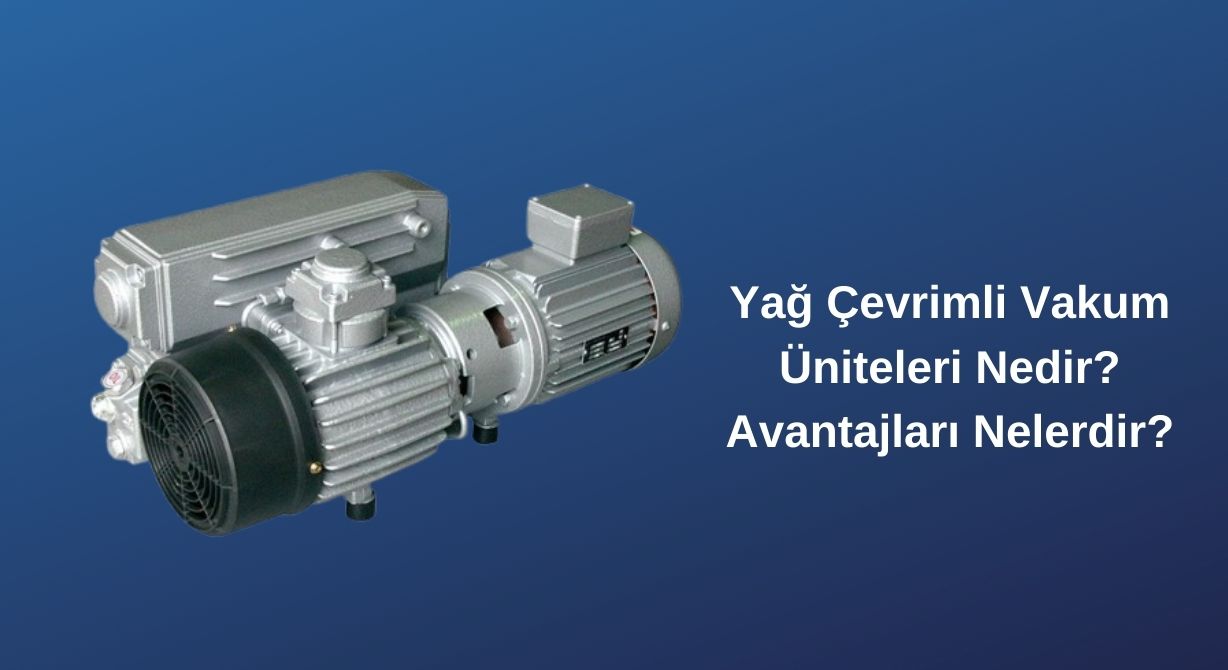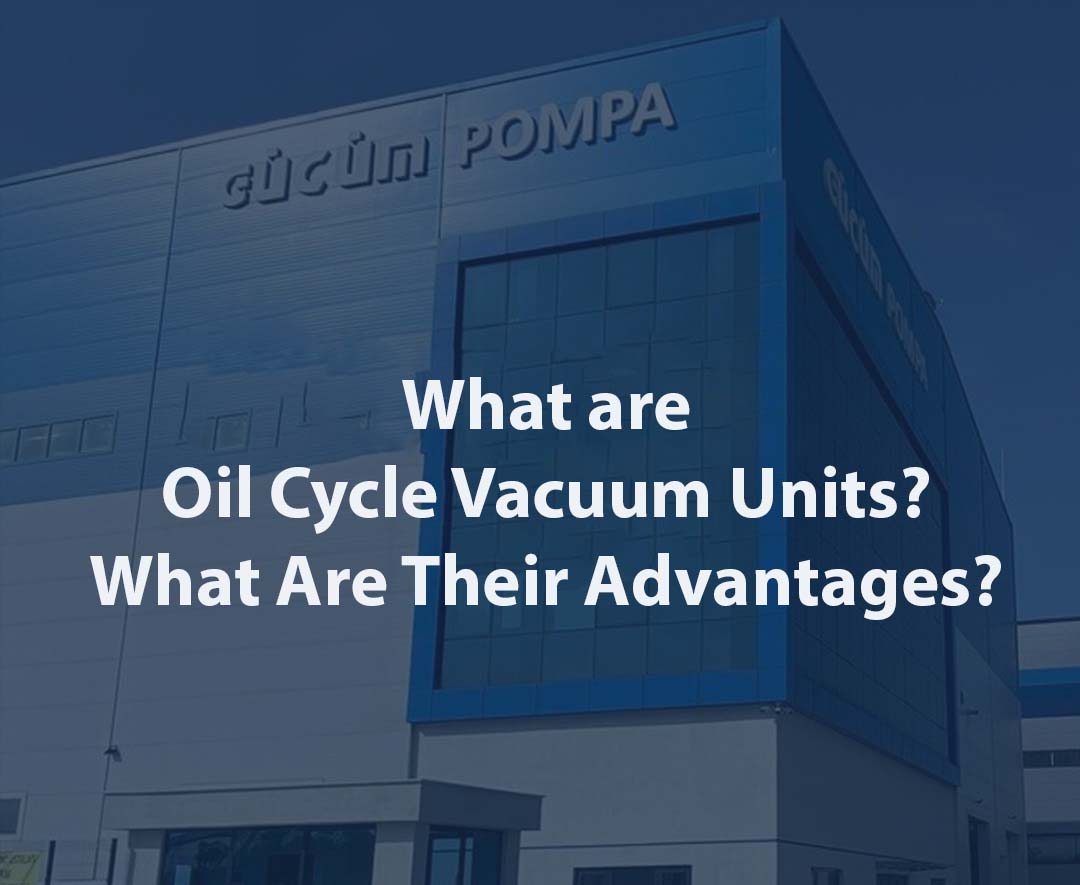What are Oil Cycle Vacuum Units? What are the Advantages?
Table of Contents
- What Are Oil-Circulated Vacuum Units?
- Operating Principle
- Applications
- Advantages
- Maintenance and Durability
- Comparison of Oil-Circulated Vacuum Units and Dry Vacuum Units
- Criteria for Choosing the Right Vacuum Unit
- Energy Efficiency and Environmental Impacts
- Oil Usage and Filtration Processes
- The Future in Industry
What Are Oil-Circulated Vacuum Units?
Vacuum technology holds great importance for systems requiring precise and efficient operation in many industries. Oil-circulated vacuum units provide a more stable and long-lasting vacuum process by lubricating the mechanical components of the vacuum pump with oil during operation. These systems are particularly preferred for achieving high vacuum levels and offer higher performance thanks to the additional sealing provided by the oil. Reliable vacuum sources are essential in industrial processes, and oil-circulated vacuum units are one of the most common solutions addressing this need. These units deliver high efficiency in both small-scale production processes and large industrial applications. Especially in areas requiring automation and precision, oil-circulated vacuum systems stand out with their robust performance. Ensuring a stable vacuum is critical for the safe and smooth progression of production processes. The advantages offered by oil-based systems significantly contribute to the efficient operation of industries. In the evolution of vacuum technology, oil-circulated systems are among the most reliable options serving this purpose.

Operating Principle
Oil-circulated vacuum units operate by creating low pressure through mechanical pumps that evacuate air and gases from the vacuum chamber. The oil inside the vacuum pump reduces friction of moving parts, minimizing wear and ensuring the pump operates efficiently for a longer time. The oil is used in a cycle and continuously cleaned, maintaining its quality and enabling the system to work efficiently. In oil-based systems, the circulating oil, along with the pump, expels the gases that create pressure from the internal environment to provide a vacuum. The oil in the system serves both sealing and cooling functions. Thus, oil-circulated vacuum units reliably provide the low pressure necessary to achieve high vacuum levels. This process enhances the efficiency of oil-based systems and ensures long-term, uninterrupted operation. The operating principle of oil-circulated vacuum units makes them preferred systems in industrial production lines.
Applications
Oil-circulated vacuum units have a wide range of applications across many industries. They are commonly used in the plastic and rubber industries for vacuum molding processes, in the food sector for packaging operations, and in medical and laboratory settings for sterilization and analysis. They are also preferred systems in metal processing, electronics manufacturing, and the chemical industry. Particularly in precision manufacturing processes, operations requiring high vacuum, and environments needing stable pressure, oil-circulated vacuum systems offer significant advantages. These units are also effectively utilized in automated systems, enhancing the efficiency of various industrial production lines. The use of such vacuum units is a common practice to ensure continuity in production processes. With advancing technologies, the applications of oil-circulated vacuum systems continue to expand day by day.
Advantages
One of the greatest advantages of oil-circulated vacuum units is their ability to achieve high vacuum levels. The oil reduces friction within the pump, ensuring the components have a longer lifespan. These systems provide a more stable operating environment compared to dry vacuum pumps, making them especially suitable for precision operations. Continuous lubrication prevents wear and mechanical failures, reducing maintenance costs. With high temperature resistance and the ability to operate uninterrupted for long periods, they can be safely used in industrial settings. The robust performance of oil-circulated vacuum units enables industrial processes to continue efficiently and without interruption. These units optimize workflows with lower maintenance requirements and fewer breakdowns. The durability of oil-circulated systems reduces production costs and provides long-term economic benefits to businesses. These features make them indispensable solutions for industry.
Maintenance and Durability
Oil-circulated vacuum units require regular maintenance to ensure long-term and efficient operation. Changing the oil at regular intervals, cleaning the filtration systems, and conducting general inspections of the pump enhance the system’s performance. Using high-quality oil and proper filtration methods increases the system’s durability, reducing long-term costs. Neglecting periodic maintenance extends the vacuum unit’s lifespan while preventing potential failures. This allows businesses to minimize unplanned downtime and increase their efficiency. With proper maintenance, oil-circulated vacuum units offer long-term use and operate at maximum efficiency. Maintenance processes elevate the units’ performance to the highest level while also improving energy efficiency. Therefore, regular maintenance extends the lifespan of vacuum units and provides long-term savings for businesses.
Comparison of Oil-Circulated Vacuum Units and Dry Vacuum Units
Oil-circulated vacuum units offer higher performance compared to dry vacuum systems. Dry vacuum units may be environmentally advantageous since they do not require oil, but oil-circulated systems excel in achieving lower pressures and more stable operation. The choice of which system to use should be determined based on the application and needs. Oil-circulated vacuum systems provide a more reliable solution, particularly in industrial applications requiring high vacuum and low pressure. Dry vacuum units stand out with their lower maintenance needs and eco-friendliness but cannot match the high efficiency of oil-based systems. Oil-circulated units are a more reliable and efficient solution, especially in critical applications. Therefore, the advantages and disadvantages of both systems should be considered to make the right choice.
Criteria for Choosing the Right Vacuum Unit
When selecting a vacuum unit, factors such as the required vacuum level, the business’s process requirements, and energy consumption should be taken into account. Maintenance costs and durability should also be considered. Choosing a unit that provides the best cost-performance balance in the long term offers significant advantages for businesses. Determining the vacuum unit most suitable for a business’s production processes is crucial for both energy savings and efficiency. When selecting a vacuum unit, its capacity, lifespan, and maintenance requirements should also be evaluated. Selecting the right unit based on these criteria allows businesses to achieve high efficiency and reduce costs. A well-chosen vacuum unit provides significant long-term benefits.
Energy Efficiency and Environmental Impacts
Oil-circulated vacuum units can be advantageous in terms of energy efficiency when used correctly. However, the oil used must be regularly changed and disposed of in a way that does not harm the environment. For this reason, modern vacuum systems are being developed with technologies that consume less energy and offer more eco-friendly filtration methods. Energy efficiency in vacuum units is a key factor in achieving sustainable production goals. Oil-circulated systems provide long-term efficiency with low energy consumption, minimizing their environmental impact. This feature offers significant benefits in reducing the environmental impacts of industrial processes. With technological advancements, vacuum systems that consume less energy are becoming more widespread. These systems pave the way for environmentally friendly production processes.
Oil Usage and Filtration Processes
In oil-circulated vacuum units, oil usage plays a significant role. The oil provides lubrication and helps cool the pump. Therefore, the quality of the oil directly affects the efficiency of the vacuum system. Properly functioning filtration processes enhance the system’s performance and ensure it operates smoothly for longer periods. For this reason, continuous cleaning and replacement of the oil are essential. Regular maintenance of filtration systems helps preserve the oil’s quality and ensures the system operates more efficiently. Proper filtration ensures the vacuum unit operates healthily and remains durable over time.
The Future in Industry
The future of oil-circulated vacuum units will be shaped by continuously evolving technology. Next-generation vacuum systems promise lower energy consumption and higher performance. With advancing automation systems and digitalization, the efficiency of vacuum units will further increase. These systems are expected to become more environmentally friendly and require less maintenance. The integration of digital monitoring systems will allow real-time tracking of vacuum system performance and enable faster interventions. With these innovations, the role of oil-circulated vacuum units in industrial processes is becoming increasingly significant every day.


